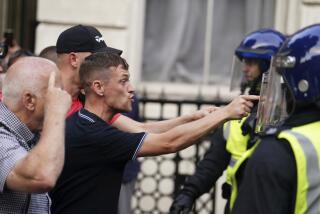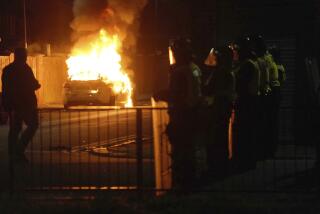2nd Day of Rioting, Looting Erupts in London
- Share via
LONDON — Youths fought sporadic battles with police Sunday as rioting and looting erupted for the second successive night in the predominantly black south London section of Brixton.
The youths attacked police with bricks and Molotov cocktails in an area close to the Brixton police station. One car was set ablaze, but the overall level of violence appeared less than that which gripped the area Saturday night.
More than 50 people, including 16 police officers, were reported injured and 150 arrested Saturday night as black youths fought running battles with police. They looted and set fire to local stores, escaping with radios, television sets and video recorders, in the worst outbreak of unrest in the troubled section in four years.
Second Bout This Month
The unrest, the second major bout of urban violence this month in Britain, casts doubts on the success of new police community relations programs in racially mixed areas that was launched after rioting swept more than a dozen English areas, including Brixton, in 1981.
It is also likely to increase political pressure on the Conservative government of Prime Minister Margaret Thatcher to reduce unemployment, currently running at more than 13%.
On Sept. 9-10, rioting in racially mixed areas of the country’s second largest city of Birmingham, 90 miles north of here, left two dead and more than 40 injured.
Bus and subway service into the Brixton area remained suspended and motorists were advised to avoid the area.
The unrest began after police accidentally shot Cherry Groce, a 38-year old mother of six, when they broke into the family home in search of one of her sons, Michael, 18. He was being sought for questioning about an armed robbery Sept. 10 of a jewelry store in which $14,000 worth of jewelry was stolen. The suspect surrendered to police Sunday.
His mother was removed from intensive care to a general ward of a London hospital Sunday. However, fragments from a 38-caliber bullet lodged in her spine have led to fears she might suffer permanent paralysis.
Police apologized for the shooting and immediately announced an investigation into the incident, but the conciliatory gestures were not enough to defuse an ugly mood which spilled into the streets and, as darkness fell, flared into violence.
Home Secretary Douglas Hurd called the police shooting a “tragic incident,” but he rejected calls from opposition Labor leader Neil Kinnock for a full-scale public inquiry, maintaining that such an investigation could jeopardize any prosecution of the police officer who did the shooting.
The officer was identified as Inspector Douglas Lovelock, 42. Scotland Yard said Lovelock was in a state of shock over the shooting.
An inspector from West Yorkshire was named to head the police inquiry, and a civilian police complaints board will also look into the incident.
‘Sense of Community’
Hurd said a major priority was “to get back to the business of building a sense of community.”
“This (rioting) shows that there are a considerable number of people, particularly among young blacks who feel they don’t have a stake in our society,” he said. “That may be partly their fault, it may be partly ours.”
After the 1981 riots, a series of measures were implemented aimed at better integrating minority groups, especially young blacks, into mainstream British society.
More to Read
Sign up for Essential California
The most important California stories and recommendations in your inbox every morning.
You may occasionally receive promotional content from the Los Angeles Times.










